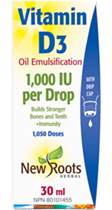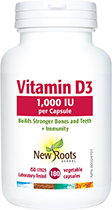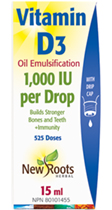Vitamin D and Adrenals—Emerging Research
Vitamin D has been in the spotlight in recent years. More Canadians are becoming aware of its importance in a number of roles including mood, immunity, and cancer prevention; and more Canadians seem aware of the importance of supplementation given our northern climates. Nonetheless, vitamin D is a hot topic amongst the research community, and new data continues to emerge. This article highlights some of the more novel applications of vitamin D based on such findings.
Often overlooked is the fact that vitamin D has a steroid structure and is actually considered a steroid hormone, similar to the sex hormones estrogen and progesterone, as well as the adrenal hormone cortisol (also known as the “stress hormone”). As such, it should not be surprising when it appears that vitamin D may augment some of the functions of these hormone signaling pathways. For instance, vitamin D has been shown to impact adrenal function and reduce inflammation—for instance, also a property of cortisol—and affect ovarian function in patients with fertility problems. This article will focus on adrenal function and inflammation.
Adrenal Function
The potential role of vitamin D in adrenal function is particularly fascinating. The adrenals are the effector organ for the hypothalamic-pituitary-adrenal (HPA) axis. The HPA axis becomes activated during times of stress, pumping out high levels of cortisol. Cortisol helps the body adapt to stress, combats inflammation, and talks to other hormones via the thyroid and ovaries. Over time, high levels of stress can lead to inadequate cortisol output, and this is commonly called adrenal fatigue.
While existence of the central hypothalamic-pituitary-adrenal (HPA) axis—made up of organs in the brain that communicate with the adrenals—has been recognized for decades, new research has described a related entity called the skin HPA axis analog.[1] This system seems to be comprised of skin pigmentation cells such as melanocytes. There seems to be a mechanism whereby local events in the skin, namely exposure to UVB radiation, seem to activate the skin HPA axis analog, which in turn interacts with and activates the central HPA axis. Indeed, research shows that exposure to UVB increases hormones such as corticotropin releasing hormone (CRH), a hormone released by the brain to signal activity to the adrenals.[1] Vitamin D appears to mediate this effect in part, and can directly increase local expression of such factors as CRF and other HPA-activating factors such as POMC (proopiomelanocortin).[2] This begs the question whether vitamin D is involved in regulating the central HPA axis, and to what extent.
Another interesting study suggests that vitamin D may have a role in regulating glucocorticoids such as cortisol during pregnancy.[3] In a study of pregnant animals, researchers induced vitamin D deficiency and compared results to outcomes in vitamin D sufficient animals. Maternal vitamin D deficiency decreased expression of an enzyme called 11β-hydroxysteroid dehydrogenase type II, which inactivates cortisol as it passes through the placenta to the baby. This is a protective mechanism, since excessive cortisol exposure during fetal life is associated with a host of adverse outcomes, including decreased fetal growth, defects in placental health and blood flow, as well as increased risk of heart disease and diabetes in adulthood.[4]
A cell line study found that vitamin D was involved in regulating cellular production and breakdown of cortisol. When adipocytes were exposed to vitamin D, they both produced two- to six-fold higher levels of cortisol, and simultaneously they increased up to two-fold the expression of the enzyme 11β-hydroxysteroid dehydrogenase type I, which is responsible for breaking down cortisol in the tissues.[5]
These studies suggest that vitamin D has a role in regulating cortisol metabolism and activity in pregnancy, as well as in nonpregnant states as well. Vitamin D appears to be involved in both the regulation of the HPA axis activation and the regulation of local cortisol concentrations at the tissue level. Although the precise relationship between vitamin D and adrenal function requires much further study and clarification, it seems that vitamin D sufficiency may be more important than previously thought in regards to optimal adrenal function.
Rheumatoid Arthritis
Cortisol is the most powerful anti-inflammatory endogenous hormone in the body. It has been hypothesized by some that suboptimal adrenal production of cortisol may exacerbate symptoms of inflammatory conditions such as autoimmune arthritis. It is therefore of interest to note that recent studies demonstrated significant benefits on rheumatoid arthritis (RA) associated with vitamin D supplementation.[6][7]
A total of 39 patients with early RA were randomized to receive standard treatment with methotrexate (MTX) and glucocorticoid medications, with or without the addition of vitamin D3 as a single dose of 300 000 IU. After three months, the patients who received vitamin D reported significantly improved general health status.[6]
Another study, of 150 patients with RA who had been on stable disease-modifying antirheumatic drugs (DMARDs) for three months, found that these patients were vitamin D deficient, and that the addition of vitamin D over a period of three months resulted in significant improvements in disease activity as well as an increase in vitamin D levels.[7]
A review paper published in 2015 examines the relationship between vitamin D and various adrenal problems and calls for further research in this area.[8] This will indeed be an intriguing area to follow in the coming years.
References
- Jozic, I., et al. “Skin under the (Spot)-Light: Cross-Talk with the Central Hypothalamic-Pituitary-Adrenal (HPA) Axis.” Journal of Investigative Dermatology Vol. 135, No. 6 (2015): 1469–1471.
- Wierzbicka, J.M., et al. “Bioactive forms of vitamin D selectively stimulate the skin analog of the hypothalamus-pituitary-adrenal axis in human epidermal keratinocytes.” Molecular and Cellular Endocrinology Vol. 437 (2016): 312–322. doi: 10.1016/j.mce.2016.08.006. [Epub 2016 Aug 12]
- Tesic, D., et al. “Vitamin D Deficiency in BALB/c Mouse Pregnancy Increases Placental Transfer of Glucocorticoids.” Endocrinology Vol. 156, No.10 (2015): 3673–3679.
- Cottrell, E.C., et al. “Foetal and placental 11β-HSD2: ahub for developmental programming.” Acta Physiologica (Oxford, England) Vol. 210, No. 2 (2014): 288–295.
- Morris, K.L. and M.B. Zemel. “1,25-dihydroxyvitamin D3 modulation of adipocyte glucocorticoid function.” Obesety Research Vol. 13, No. 4 (2005): 670–677.
- Buondonno, I., et al. “Vitamin D and immunomodulation in early rheumatoid arthritis: A randomized double-blind placebo-controlled study.” PLoS One Vol. 12, No. 6 (2017): e0178463. doi: 10.1371/journal.pone.0178463. [eCollection 2017]
- Chandrashekara, S. and A. Patted. “Role of vitamin D supplementation in improving disease activity in rheumatoid arthritis: An exploratory study.” International Journal of Rheumathic Diseases Vol. 20, No. 7 (2017): 825–831.
- Muscogiuri, G., et al. “Focus on vitamin D and the adrenal gland.” Hormone and Metabolic Research Vol. 47, No. 4 (2015): 239–246.

Philip Rouchotas, MSc, ND
Well-known in the community as a naturopathic doctor, associate professor,
and editor-in-chief of Integrated Healthcare Practitioners.

Heidi Fritz, MA, ND
A practicing naturopathic doctor since 2007, her areas of focus include
women's health, children's health, chronic pain, and more.

 Stores
Stores


